Australian Capital Territory
University of Canberra
Semester 1 has drawn to a close and we are settling in for the long chilly Canberra winter.
We are all glad to be back learning in the Lab, especially the Commonwealth Supported Place cohort who had their first semester learning about the ins and outs of materials conservation.
The Lab also welcomed Kes Elliot as the intern for Semester 1. Kes has done a wonderful job and we wish her all the best in her future endeavours.
The Sydney Harbour Bridge project is progressing well with the laser facilities soon to be up and running. Alison Wain and Julia Brand will also be visiting the Moruya Quarry to gather more samples of granite to be tested with laser cleaning. Alison is also looking at a potential project that utilises lasers for conserving heritage affected by bushfires and the inclusion of heritage values in planning for disaster recovery and resilience.
The conservation team is also offering a suite of short courses this winter:
- Insect identification for Museum Collections
- Introduction to Photographic Conservation
- Preserving Paper Collections Part 1
- Preserving Paper Collections Part 2
Do visit https://www.canberra.edu.au/ucpro for more information and to sign up for the short courses.
Finally, we would like to congratulate all the students who have graduated this semester. The world is your oyster!
New South Wales
Australian Museum
Collection Care and Conservation
The Collection Care and Conservation team is settling well into the new conservation lab. The team has enjoyed being able to work together in the same space again! Heather Bleechmore continues in the role of Acting Manager to oversee operational business.
Staff changes
We farewell Emily Vearing as she moves into an exciting new role at the NSW State Archives.
Sheldon Teare has been appointed Senior Conservator of Natural Sciences. This is a well-deserved appointment and reflects the leadership and expertise that Sheldon brings to the Collection Care and Conservation lab.
Treatment project
A large diprotodon (Diprotodon optatum) cranium has been brought into the lab, which has only been partially excavated. Sheldon will be working with the team to see this large specimen fully removed from the surrounding matrix. The treatment has been set up next to our newly opened viewing windows so the passing public can see the work in progress.
Michael Kelly continues working on the Archives and Library collections. He is currently assessing material in preparation for safe handling during the Library’s digitisation program and carrying out stabilisation treatments where necessary.
Rehousing Types projects
Sophie Phillips has continued work on re-housing the Palaeontology Type Collection. So far over 2500 specimens have been rehoused. The type collection contains some of the most significant and valuable palaeontology specimens, so it is wonderful to see them well supported and protected in their new housing.
Melissa Holt and Emily have continued to work in the Mammals, Birds, Fish and Minerals departments to assess and condition report Dry Type specimens. With the project coming to an end at the beginning of June, they have completed over 1300 condition reports, with over 8000 documentation photographs captured and linked to the EMu database. To date, 1150 specimens have been rehoused in custom designed boxes and archival grade materials. The remainder will be passed on to be completed after the end of the project.
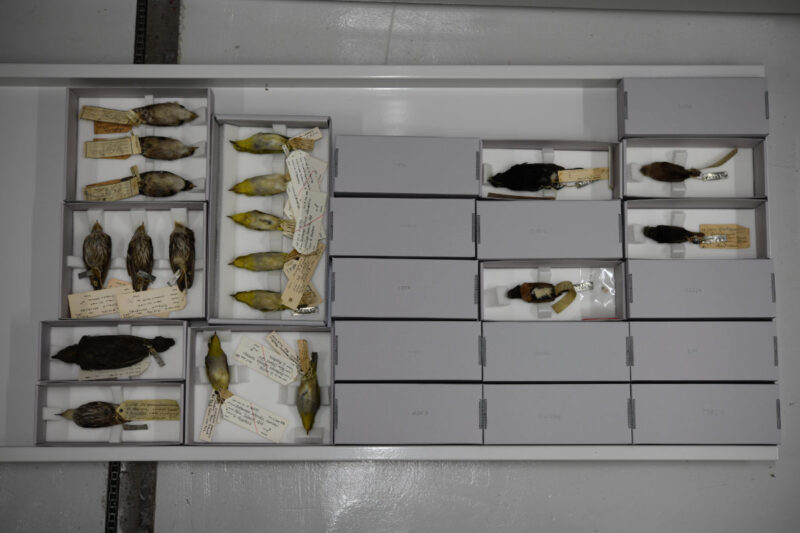
Above: Example of a number of bird specimens rehoused and back on their shelf.
Collection enhancement project
Clare Kim is investigating a mysterious white substance forming on the interior surfaces of glass lids of Entomology collection drawers. The substance has the appearance of fogging and resembles crystal structures. Visual examination against a dark background with raking light revealed that this substance has formed roughly in the shape of the unit trays stored in the collection drawers. A few samples have been taken to analyse with Attenuated Total Reflection Fourier Transform Infrared (ATR-FTIR) spectroscopy. Although all the findings are not yet fully identified, the substance is likely to be fatty acid. It is possible that fatty acid leached out from the specimens and migrated to the glass lid. Gas chromatography-mass spectrometry (GC-MS) analysis is planned for future testing to obtain more accurate data.

Above: Possible layout of collection unit trays based on traces left on the glass.
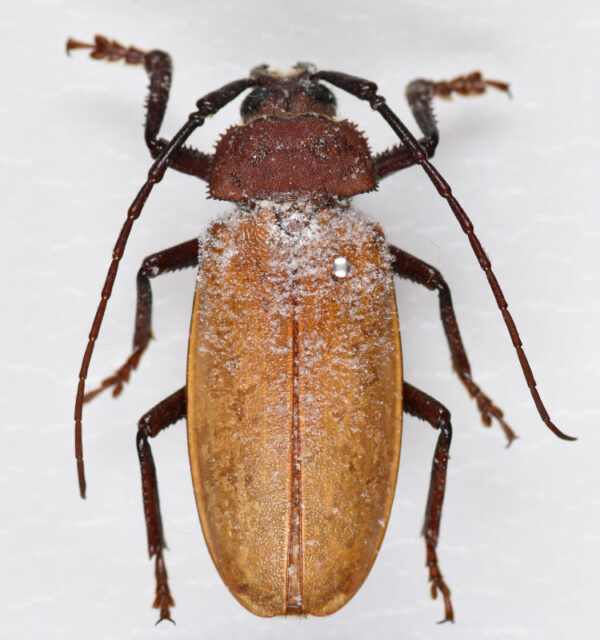
Above: Image of specimen with possible fatty acid.
Exhibitions
The opening of the Unsettled exhibition was a huge success! Robert Clendon and Kyra Kim worked tirelessly alongside the exhibition preparators to install the First Nations material in this significant truth-telling show.
Megan Dean-Jones and Kyra Kim have begun assessing the mineral specimens for the new Minerals Gallery due to open late 2022.
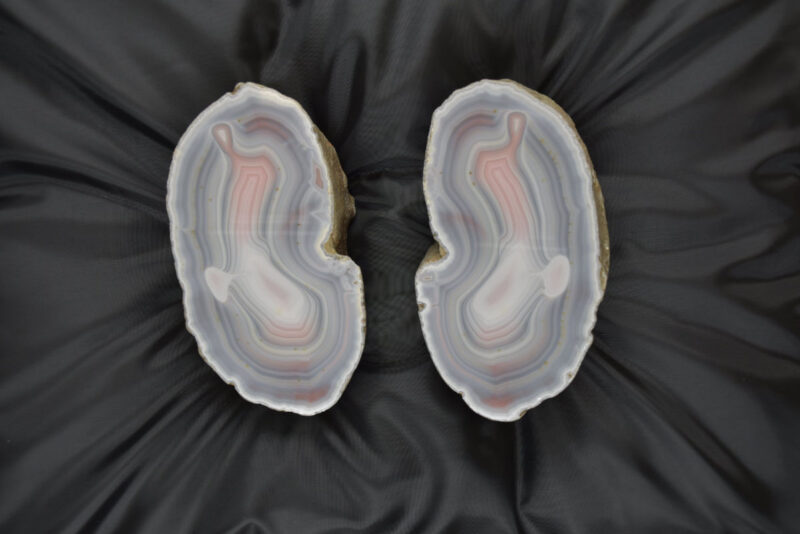
Above: Pair of agate mineral specimens.
Collection Care
The new IPM treatment room is now up and running. The nitrogen chamber and freezer have been relocated to the new space allowing for CC&C to resume business as usual for the treatment of material for museum pests. It is exciting to be in a new space and to have the nitrogen chamber again to conduct large scale anoxic treatments.
Australian National Maritime Museum (ANMM)
Staff changes
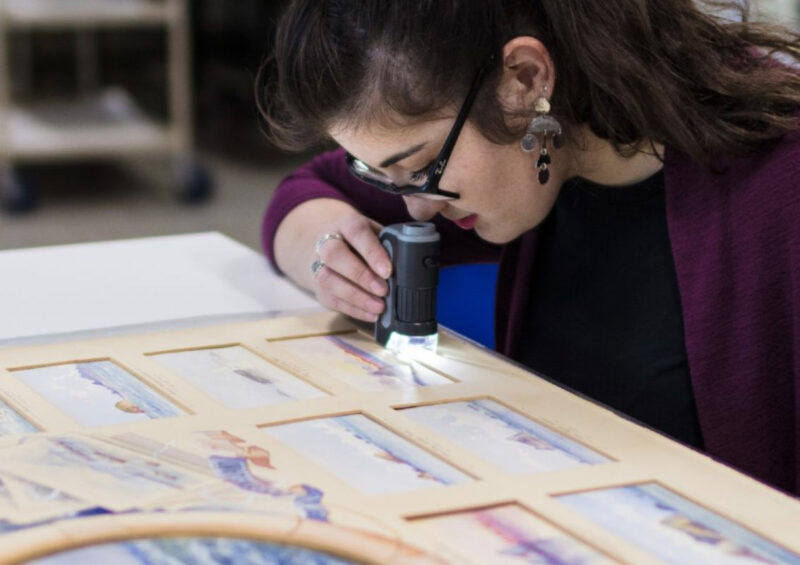
Above: Farewell to Luci ‘Lucky’ Ronai. Image by K Pentecost.
In late April, with handkerchiefs in hand, we gave a teary farewell to Luci Ronai, who is off to start in an exciting new position at the National Library of Australia. Over the course of four and a half years, Luci has made an invaluable contribution to the preservation of the National Maritime Collection (especially to paper, books and photographs, cellulose nitrate and cellulose acetate and collection safety). Through her academic publication, innovation in public programs, directing ANMM’s Museum Dance Off video and her personal YouTube channel (The Conservation Starter), Luci has become the public face of conservation at the museum. ‘Lucky’, from the bottom of our hearts, thanks for being a wonderful colleague and a dear friend.
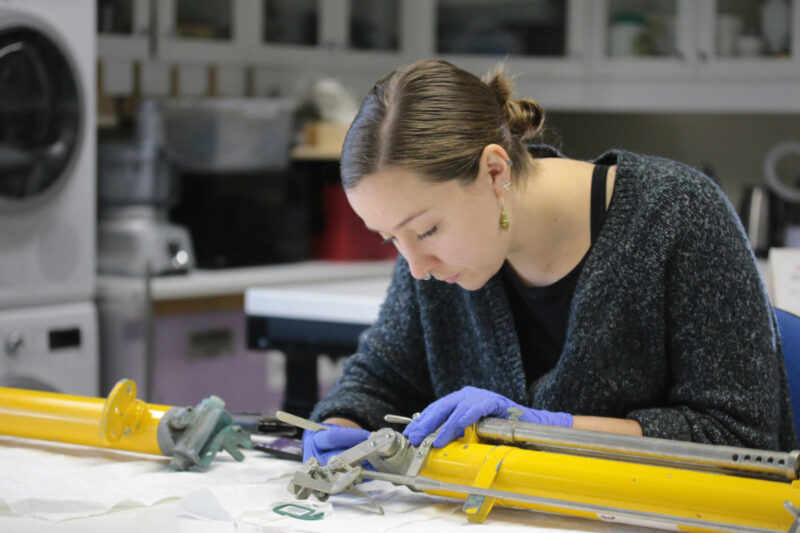
Above: Emma Hayles conserving a Nansen bottle for the One Ocean Our Future exhibition. Image by N Flood.
Emma Hayles has recently joined the ANMM conservation team. Coming to us from MAAS and Grimwade Conservation Services she brings valuable experience in archaeological conservation. Welcome aboard Emma.

Above: Jan Russell stuffing and sewing object cushions. Image by N Flood.
Our conservation volunteers Jan Russell and Sue Brien have returned to the lab after being kept away for most of 2020. Jan is busy sewing new object cushions and Sue is working on a number of rehousing projects.
Treatment projects
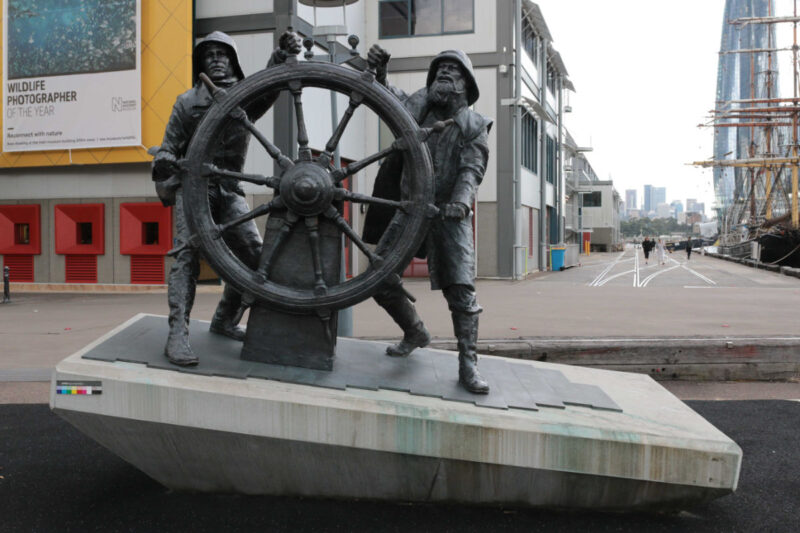
Above: Windjammer Sailors (Brett Garling) after treatment, overall. Image by N Flood.
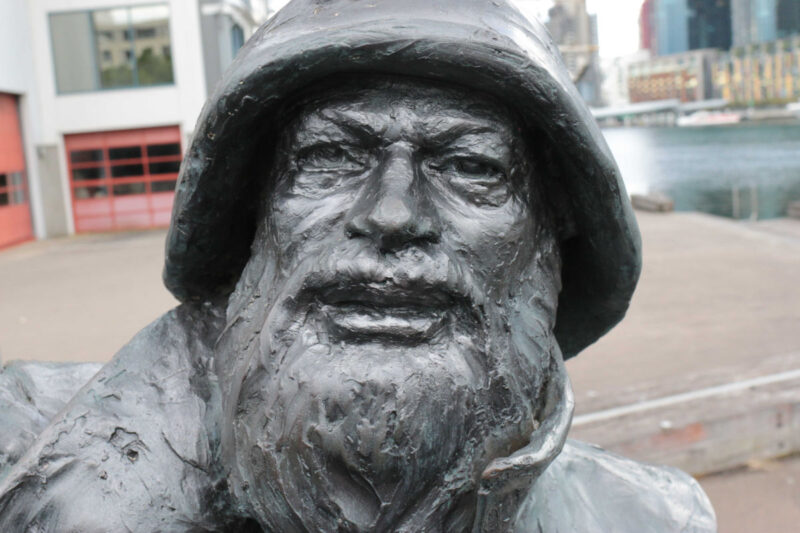
Above: Windjammer Sailors (Brett Garling) after treatment, detail. Image by N Flood.
Windjammer Sailors (Brett Garling) is the bronze sculpture that sits proudly in front of the museum’s admin building. In May, we completed a routine clean and replenish of its distinctive graphite wax coating to help protect it from the constant public interaction it receives.
Exhibitions

Above: Blue Nemo unmanned surface vessel and test propulsion models. Image by R Orchard.
Work on objects for upcoming One Ocean Our Future exhibition is progressing. Many recent acquisitions in the science and technology collection area are being used for this show, including Blue Nemo an unmanned surface vessel and test propulsion model.
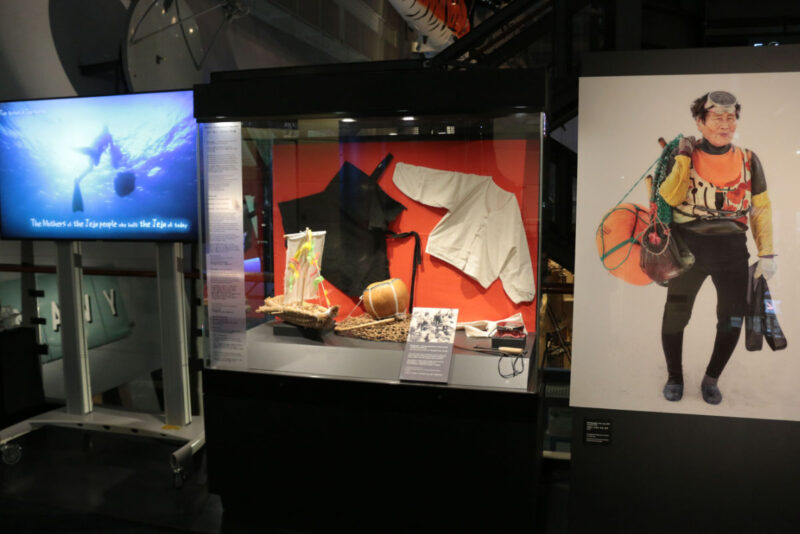
Above: Gallery view of Haenyeo: The sea women of Jeju Island. Image by N Flood.
Haenyeo: The sea women of Jeju Island is a touring exhibition of traditional diving equipment and photographic portraits that tells the story of Jeju’s ‘sea women’. Aged in their 60s, 70s and 80s, these women harvest seaweed, shells and seafood from the island’s treacherous waters.
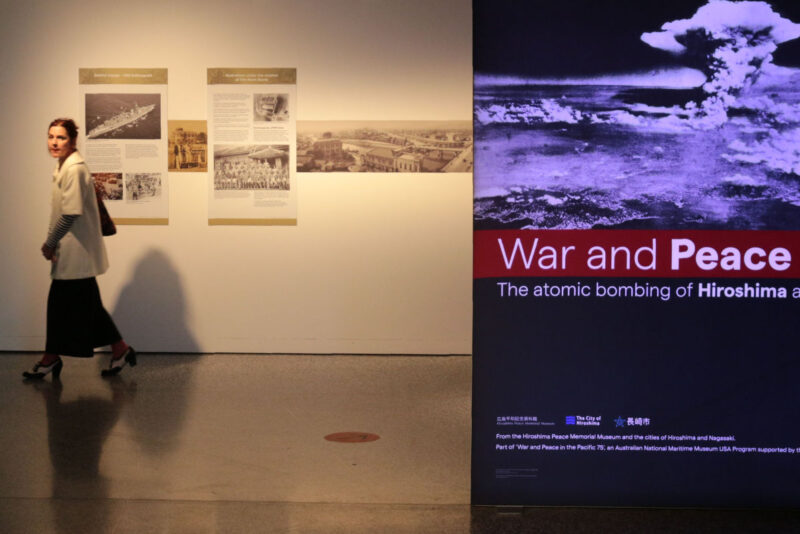
Above: Gallery view of War and Peace: The atomic bombing of Hiroshima and Nagasaki. Image by N. Flood.
War and Peace: The atomic bombing of Hiroshima and Nagasaki is an exhibition that has travelled from the Hiroshima Peace Memorial Museum. Alayne Alvis processed the 20 loans that went on display, including objects that survived the bomb blasts (clothing, chopsticks, pocket watch, etc.) and a peace crane folded by former US president Barrack Obama.
International Conservation Services (ICS)
ICS visitors
Our news update provides a snapshot of what we love doing, but we also enjoy talking about what we do! Two recent events allowed us to share with others our passion for conservation.
On 11 May 2021, we held a show and tell for National Trust of Australia (NSW) supporters. Our visitors were divided into two groups that alternated between a talk about the process of conservation and a tour of the labs. Each group was meant to take the same amount of time, but inevitably we got talking and our guests got talking – especially once we were in front of an object or artwork – and our plans did get a little out of kilter … It reaffirmed how pleasurable it is to talk to interested folk about what we do. Conversely, we saw how fascinated people are by processes and outcomes of our conservation work. Long may it continue that way!
Our second event was a visit by members of the AICCM NSW branch on 20 May 2021, which gave us a chance to show off our refurbished labs. It was great to see a good turnout and catch up with our Sydney-based colleagues.
Furniture
Furniture continues to be busy and productive. Work is almost complete on a beautiful escritoire that required the removal of dark over-polish and some intricate veneer work. We are also working on a fine collection of mid-18th century English furniture that includes a double-backed settee and a beautiful Georgian secretaire chest of drawers. Oliver Hull is also finalising work on a PNG totem and a pair of Gillows Lancaster games tables.
Paintings
Matteo Volonté and Claire Heasman (and Christina Ritschel in Textiles) have been busy stabilising a painted Oddfellows Fraternity banner. This treatment is proving both interesting and difficult due to the fact it is painted on both sides.
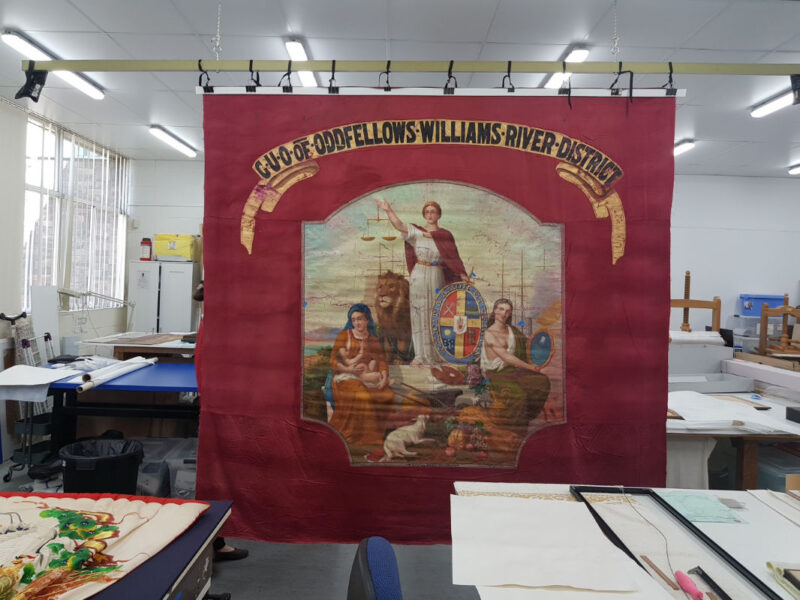
Above: Oddfellows Fraternity banner during treatment. Photo by International Conservation Services.
Eden Christian has been treating a beautiful triptych for the Australian Catholic University, which suffered damage from mould. Our paintings conservators have also completed works on a large collection for the Gold Coast’s HOTA (Home of the Arts), including preparation of The Rainforest by William Robinson for exhibition. The work is now on display in the HOTA Gallery’s second major exhibition, Lyrical Landscapes
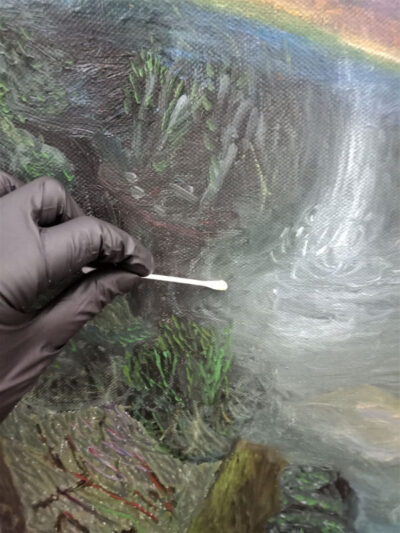
Above: Conducting solubility tests during treatment of The Rainforest by William Robinson. Photo by International Conservation Services.
Textiles
In the Textiles department, Christina Ritschel is working on a chaise longue and grandmother chair from Sydney Living Museums, where the upholstery had collapsed. The philosophy is to return the items to how they looked when Sydney Living Museums took over the Rouse Hill estate in the 1960s. Christina is also applying a newly developed method of using rare earth magnets to mount a Japanese wedding kimono. Work continues on an 1840s white cotton lace dress for the National Trust. The dress has been wet cleaned and is awaiting further treatment.
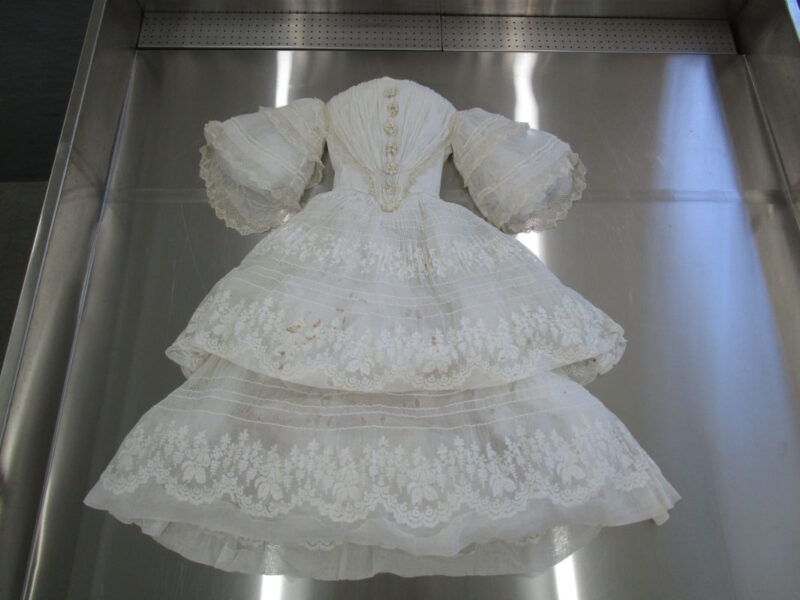
Above: 1840s white cotton dress awaiting further treatment. Photo by International Conservation Services.
Paper
The Paper department is in the midst of a massive mouldy book remediation, which involves cleaning over 400 boxes of books. Katie Wood is overseeing a number of casuals who are making great progress, with excellent results from our spore testing. Suati Rojas recently prepared a Banksy print for auction, which achieved great results. And Yolanda el Khouri is busy with a mould remediation of a beautiful bible from 1572. Suati and Katie undertook an extremely challenging Brett Whiteley treatment with an amazing transformation. The very sensitive red ink stamps needed to be isolated so that careful extraction of a discoloured adhesive backing could be undertaken.
Objects and Outdoor Heritage
The start of 2021 has been a busy time for OOH at ICS.
Firstly, we have had the pleasure of welcoming Keir Bayley to the team, in the newly created role of Conservation Heritage Trades Specialist. Having previously worked for a fine art sculpture foundry, Keir brings with him a wealth of knowledge and invaluable craft skills and we are excited to have him on board!
Nicola Ashurst has recently overseen conservation treatment and repainting of the HMAS Parramatta Memorial at Queen’s Wharf Reserve in Parramatta. The memorial features the stern of the ship, which required extensive preparation of the metal surface.
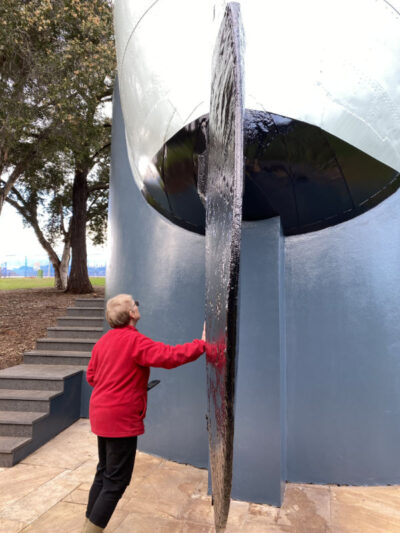
Above: Nicola viewing the completed HMAS Parramatta Memorial, which is looking shipshape once again. Photo by International Conservation Services.
Wendy Reade has been working on a meteorite and an eggshell-thin Chinese porcelain bowl. Amongst other on-site projects, Wendy is also preparing for the conservation of two Norman Lindsay sculptures in the garden of his home, now the Lindsay Gallery in Blackheath. This property is managed by the National Trust (NSW).
In time for ANZAC Day, Claire Rowson delivered two beautiful new wooden gun carriages to Richmond, which were fabricated in collaboration with master wheelwright Mark Burton. Claire also managed the complex logistics of receiving four very large and very heavy bronze doors from the NSW Department of Education Building at our Chatswood workshop.
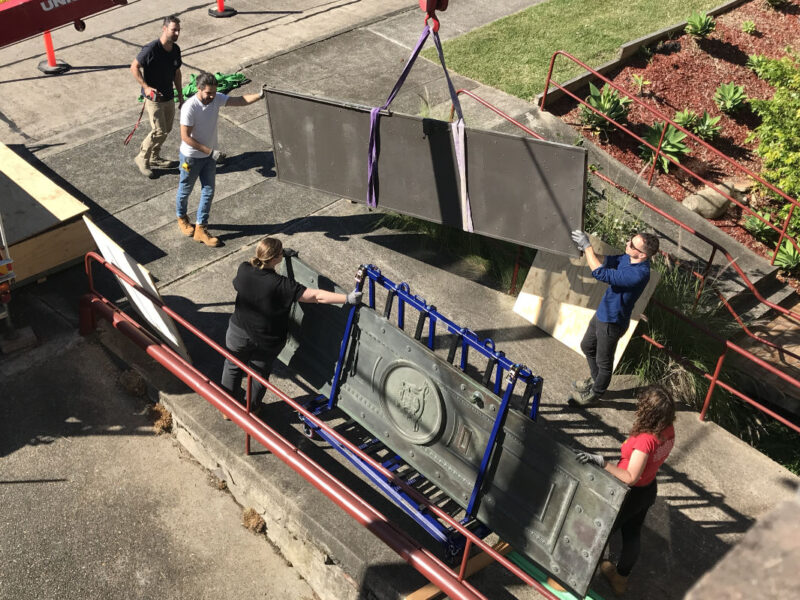
Above: All hands on deck, assisting Claire with unloading the bronze doors. Photo by International Conservation Services.
Amy Walsh has undertaken assessment and maintenance at several archaeological sites in Parramatta, including instigating a comprehensive pest management strategy at one of them. She also recently had the pleasure of restoring a beautiful porcelain vase with crystalline glaze for a private client, who was very happy with the work.
OOH recently had the opportunity to attend a professional development session with Clive Calder from Australian Bronze. The team spent the afternoon at the Manly foundry, learning about bronze casting and patination. We had the chance to view demonstrations of hot patination techniques and a night-time bronze pour.
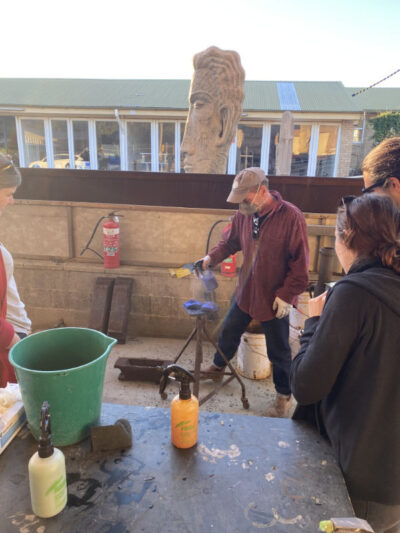
Above: The team watching Clive in action, applying a beautiful blue patina. Photo by International Conservation Services.
There have also been two occasions for celebration for the OOH team!
Nicola Ashurst received recognition for her previous work with Adriel Consultancy on Shell House in the Sydney CBD. The Shell House project was awarded Winner, Conservation Built Heritage, as part of the National Trust (NSW) Heritage Awards 2021.
Additionally, Wendy Reade has just had her PhD thesis on early glass technology and raw materials published by Archaeopress as The First Thousand Years of Glass-Making in the Ancient Near East.
Congratulations to Nicola and Wendy!
Comings and goings
Sadly, in April we farewelled Sergio Merida, who moved to Far North Queensland for a lifestyle change.
Also in April we welcomed to the Objects & Outdoor Heritage Team Keir Bayley, as our new Heritage Trades Specialist. Keir brings a formidable set of skills in bronze casting, metal fabrication, fibreglassing, mould making, patination and polishing. In addition, Keir is experienced in sculpture installation, training and project management.
We also welcomed Luke Mitchell, working as our part-time Conservation Technician in the Furniture team. Luke’s really useful skillset includes woodworking, repairs, landscaping, building, training and project management.
Museum of Applied Arts and Sciences (MAAS)
Staff changes
Chris Redman has been appointed Conservator, Variable Media. Chris will continue to develop policy and procedure and build the Museum’s variable media workstation.
Kris Bullen has been appointed Conservator, Hazards. Kris will be assisting Brooke Randall and Jessie Gray in managing hazardous materials in the collection.
Margot Murray, Rebecca Ellis and Megan Hall have moved from the Collections Relocation and Digitisation (CRD) Project to the Exhibitions Team. Bronwyn Dunn has been appointed Conservator, Museums Discovery Centre.
Wajeeda Tabassum has moved from the CRD Assessment Team to the CRD Conservation Team. Wajeeda will be undertaking stabilisation of ceramic and glass objects in preparation for digitisation and transport.
Will Sit, CRD Assessment Team Leader, has left MAAS to work for private practice. Freya Gabbutt will be acting in the position until further notice.
The Assessment Team also farewells assistant conservators Felise Reakes, Emma Hayles, Jessica Walsh, Ruth Drayson and Danica Auld and welcomes assistant conservators Caitlin Knight, Monica Connors, Margaret Barclay and Sonia Lee.
Project and treatment update
Conservation staff have been involved in the restoration of Sydney Observatory’s Messenger’s Cottage, returning it to how it appeared in the 1890s. They have consulted two heritage architects and a heritage tradesman. The windows have been repaired and the internal walls stripped of lead. They are currently sourcing a distemper specialist to paint the interior. Once completed, the cottage will be used for artists and scientists in our MAAS residency program.
Conservation research
Brooke Randall is currently participating in two Australian Research Council Grants and will be hosting several PhD and Masters students in the coming months. Brooke is also developing research projects to be undertaken in collaboration with the Australian Nuclear Science and Technology Organisation (ANSTO). This includes undertaking analysis at the Australian Centre for Neutron Scattering and Melbourne Synchrotron.
Preventive conservation programs
Jessie Gray has developed and implemented a new method of analysis for the collection of pest data. The reports developed from this data analysis will be retained as a record providing us with a database for long-term monitoring in our collection stores. Furthermore, they allow us to better track and communicate pest-monitoring information and determine the effectiveness of our IPM strategies.
We have undertaken a new (to MAAS) method of pest eradication with the use of a damp heat chamber for high-temperature treatment. Due to the short lead time between an upcoming exhibition install date and the material sensitivity of a painted wooden object, we did not want to use a low temperature treatment and did not have enough time for an anoxic treatment. With assistance from the Australian Museum, who have previously used this treatment method, we undertook extensive research and a series of experiments and have since carried out a successful treatment of our material.
Exhibitions
Our exhibitions conservators are very busy with the upcoming Eucalyptusdom opening on 1 July. The exhibition reckons with our cultural history and ever-changing relationship with the gum tree, presenting over 400 objects from the Museum’s collection alongside 17 newly commissioned works.
Robert Rosen: Glitterati opens on 6 August followed by Clay Dynasty on 29 August. Clay Dynasty celebrates studio ceramics in Australia, featuring hundreds of ceramics from the Museum’s collection alongside loaned and commissioned works.
Loans
This month, Dave Rockell installed several objects at Newcastle Museum. This visit also incorporated a site and access assessment for the loan of several vehicles including the 1955 FJ Holden Special and Tram Hearse Trailer and Coffin.
Several large loans are pending including a loan to the Hurstville Museum and Art Gallery, which is borrowing a range of objects for display in an exhibition entitled Our Journeys, Our Stories on the history of Chinese migration to the Georges River area in Sydney. Preparations are also underway for a display within the offices of NSW State Treasury. This involves a collection of weights and measures associated with early Sydney as well as an assortment of coins of different nations.
There is also a large collection of objects relating to Federation, medicine and birthing heading to the Museum of Australian Democracy for their redeveloped ‘Changemakers’ gallery.
O’Sullivan Conservation
William Sit and Mitchell Bentley have been welcomed to the team as Objects Conservator and Conservation Technician, respectively. William comes to O’Sullivan Conservation with a wealth of objects conservation experience gained at various private conservation firms and public institutions, both domestically and internationally. Mitchell has worked as a rigger and furniture removalist for the last nine years, with the six years prior to that spent working for a large furniture finishing firm in Sydney after completing his training at TAFE.
Both William and Mitchell are proving to be indispensable members of the team already, and we look forward to the future.
Professional news
Congratulations to Eoin on becoming a professional associate with the American Institute for Conservation; he went through a rigorous review process to be accepted and it is fantastic to see his conservation skills recognised. This also provides further international relationship and network building opportunities to O’Sullivan Conservation.
Treatment projects
The team has enjoyed working on a variety of projects in the last three months, including undertaking a conservation treatment of a copper-alloy fountain of Venus from a pontoon located at the Royal Botanic Garden Sydney, and a condition assessment and conservation clean of Material World light boxes, Merilyn Fairskye (1999), in the Devonshire Street Tunnel, Sydney.
Eoin, Hannah, Kaleigh and Mitch were privileged to undertake a conservation treatment of the Wellington Cenotaph (NSW), designed by the well-known Marrickville sculptor Gilbert Doble, which features three electrotype copper sculptures including the sword-wielding ‘Winged Victory’, the ‘Spirit of Australia’ upon entering WWI, and ‘History’. This included seam repairs, previous repair rectification and replacement of a finger. Our local procurement policy held us in good stead, with the replacement finger fabricated by Wongarbon artist Brett ‘Mon’ Garling, whose bronze sculptures can be seen throughout regional NSW.
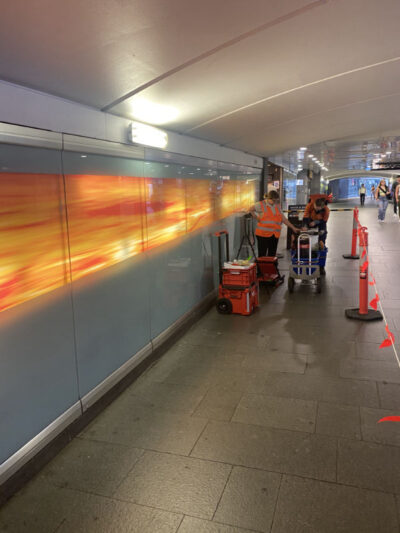
Above: Hannah and Kaleigh setting up on-site at Material World.
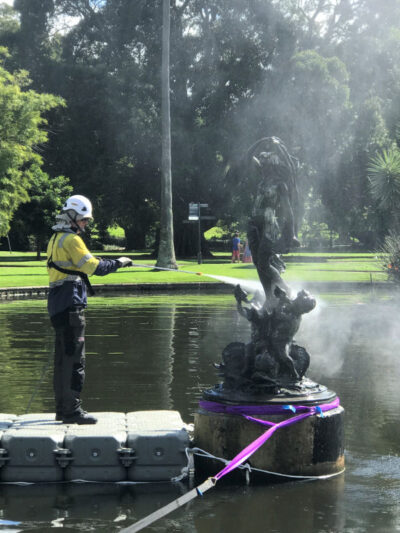
Above: Eoin pressure washing Venus from a pontoon at Royal Botanic Garden, Sydney.
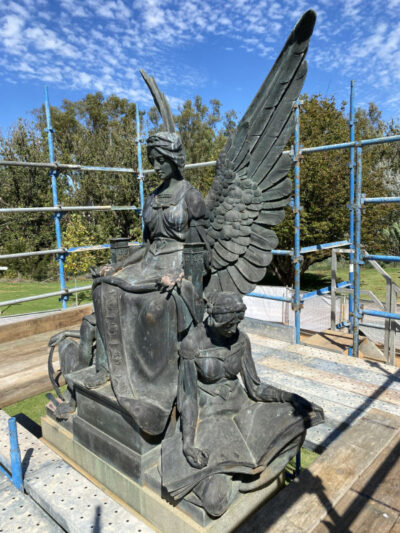
Above: Wellington Cenotaph sculptures before treatment.
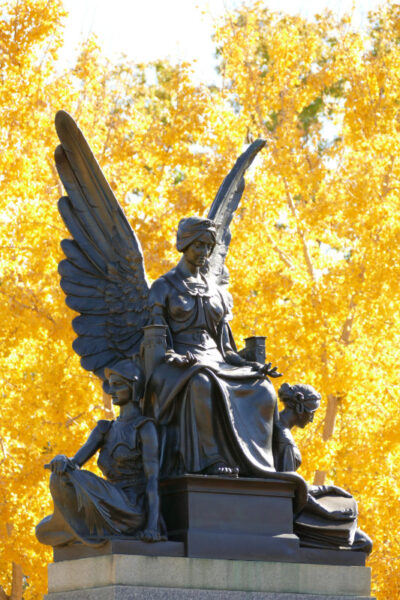
Above: Wellington Cenotaph sculptures after treatment.
State Library of New South Wales
Professional news
Books , Objects and Paintings
The BOP team is busy preparing material for upcoming exhibitions opening in July. Nikki Ellis has been preparing 19th and 20th century pamphlets and books on magic for How’s Tricks and Steve Bell has been stabilising fragile bindings, doing minor repairs and making lots of book cradles for 20 atlases and books from the 16th to 18th centuries for Mapping the Pacific.
Guy Caron is treating daguerreotype miniature cases that have been identified as needing some attention from the Paper & Photograph team’s miniatures survey and is also surveying an extensive selection of old and fragile bound material for an exhibition on medicine due to open at the end of the year.
Felicity Corkill is working with Catherine Thomson on preparing our realia collection for relocation during the upcoming building works.
Digitisation
The Collection Care Digital Excellence Project team has recently completed conservation treatment of the Tasmanian papers, comprising 368 volumes of official records relating to the government and administration of Tasmania. The DEP team has been working on this collection since 2014! Treatment has involved cleaning mould, consolidating leather affected by red rot, repairing pages and covers and, finally, rehousing the volumes in preparation for digitisation.
The team has also been very busy assessing, treating and preparing county plans, town plans and parish maps for offsite digitisation. These collections are estimated to consist of over 14,000 items! Some of the plans are in poor condition and have required extensive treatment. Recently, Keyeele Lawler-Dormer and Hoa Huynh completed a double lining of a large diazotype plan with hand-coloured watercolours from the Cumberland County as the plan had considerable fracturing and losses along the fold lines. Paula Thorby has also been working on the rehousing of glass plate negatives by Harold Cazneaux, a pioneer of Australian pictorialist photography. This collection contains over 800 glass plate negatives from approximately 1920–48.
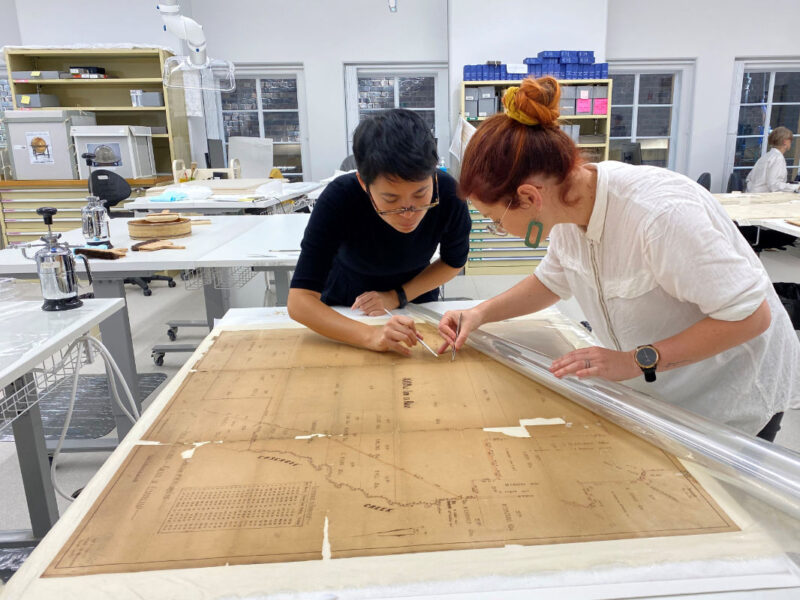
Above: Hoa Huynh and Keyeele Lawler-Dormer carefully removing sutures during a lining treatment of a county plan. Image: Kate Hughes.
Lab news
There was a formal opening of the new Ainsworth Conservation Laboratory on Monday 24 May to thank Len Ainsworth AM for his generous donation towards the lab build. It was attended by Library Council and Library Foundation board members and staff.
Following the consolidation of the Collection Care Branch in the new Ainsworth Conservation Laboratory, we are now able to commence refurbishment of our secondary space, the former Domain Lab. This will provide a screening and processing space for potential acquisitions (a quarantine room) and a space for some large equipment and for mounting, framing, crating and collection housing work.
The Domain refurbishment will enable relocation of large equipment and supplies, facilitating new public access between the two library buildings in time for the building of a new auditorium, mobility access improvements, and a new gallery.
Tasmania
Tasmanian Museum and Art Gallery
The TMAG conservation team has been working on preparing objects for the opening of the Children’s Gallery mapiya lumi / around here to display specimens from the collection interspersed with 3D printed replicas and video animation.
Another project that is keeping the conservators busy is the upcoming exhibition Paradise Lost on the life and art of convict artist Thomas Griffiths Wainewright. The recreation of Wainewright’s boudoir has been enabled by the conservation efforts of Michelle Berry and Nikki King-Smith. The innumerable sketches and etchings in the exhibition have been carefully conserved, and some reframed to match the period, by Cobus van Breda. The paintings have been prepared by Jennifer O’Connell and include one from the TMAG collection that has recently been attributed to Wainewright after research by the curator. Infrared photography assisted with ascertaining some stylistics attributes prior to previous restoration, particularly around the sitter’s lips. The mirrors and frames have been prepared by Lisa Charleston, with one frame in particular requiring remoulding of missing elements. The juxtaposition of European Romanticism and convict Tasmania is being brought to life by the furniture, paintings and works on paper, and even a special sealed section of drawings, which has brought some display challenges beyond lux levels.
In terms of loans, Lisa and Jenny prepared large-format mid–late 20th century paintings from the collection for two separate loans, which also signalled the last of delayed loans from 2020. As part of TMAG’s Indigenous Roadmap commitments, Lisa participated in developing strategies for Acknowledgement of Country signage and Apology responses. In terms of training this year, the conservation team will join all staff at the TMAG in cultural competency training as part of the organisation’s commitment to the Indigenous Roadmap.
Victoria
Australian Centre for the Moving Image (ACMI)
Registration and Exhibitions
Our Registration team, conservators from Objects Conservation Melbourne, art handlers from Exhibitone and a visiting Disney Courier have completed the installation for Disney: The Magic of Animation exhibition. With over 500 artefacts including prints, drawings, concept art, moving-image footage, and a model village made entirely from sweets, it has been a huge installation now diligently maintained by our Registration team.
ACMI’s new permanent exhibition The Story of the Moving Image (SOMI) is approaching its six-month preventive conservation changeover mark, where our team will be swapping out vulnerable objects to ensure their longevity, including costumes, paper objects and a suite of magic lantern slides. ACMI’s Registration team is working on treatments with Marion Parker and Objects Conservation Melbourne on the new objects, ready to be displayed in August 2021.
Our Exhibition Touring team recently hit the road again to install Cleverman at Gosford Regional Gallery. This was their first ‘in-person’ install after a period of delivering exhibitions remotely—a strategy that saw Head of Touring Anat Meiri and her team revising all of their regular documentation strategies and delivery modes.
Collections
The next phase in our preservation work with the Archiving Australian Media Arts (AAMA) and Play it Again 2 (PIA 2) ARC’s are underway. Led by Professor Melanie Swalwell in collaboration with partnering organisations, the PIA 2 ARC sees Digital Preservation technicians Ben Abbott and Mar Cruz with PhD candidate Caroline Choong and Digital Preservation expert Cynde Moya imaging, archiving and emulating Australian videogames from the 1990s. This builds upon the preservation work already achieved through the Play it Again I (ARC) that ensured nostalgic videogames such as Aussie Games and Way of the Exploding Fist were playable again.
Candice Cranmer (Collections), Serena Bentley and Fiona Trigg (Exhibitions) have conducted preservation interviews with Daniel von Sturmer for CATARACT (concrete) and Gabriella Hirst for her work Darling Darling. These newly acquired works, join ACMI’s ever-expanding time-based media collection and the preservation interview, recorded as auxiliary documentation, provides an invaluable roadmap for guiding future preservation parameters. Thanks to Basi Dabrowa (AGNSW) for also sharing the gilding process undertaken with Hirst for this work (also shown at AGNSW).
Jesse Dyer has joined the Collections team as the newly appointed Grimwade and ACMI Time-based Media Fellow. His research will focus on complex time-based media artworks that use game engines such as Unity™ in their creation and or function and he will also develop a suite of documentation strategies with GCCMC, GCS and ACMI around complex digital artefacts.
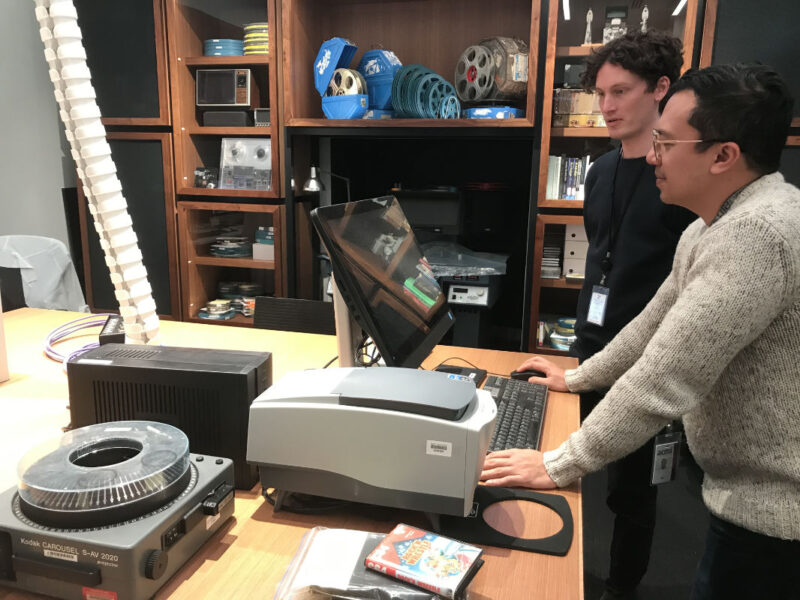
Above: Jesse Dyer and Mar Cruz imaging artworks and videogames in ACMI’s Blackmagic Design Media Preservation Lab. Image: Candice Cranmer
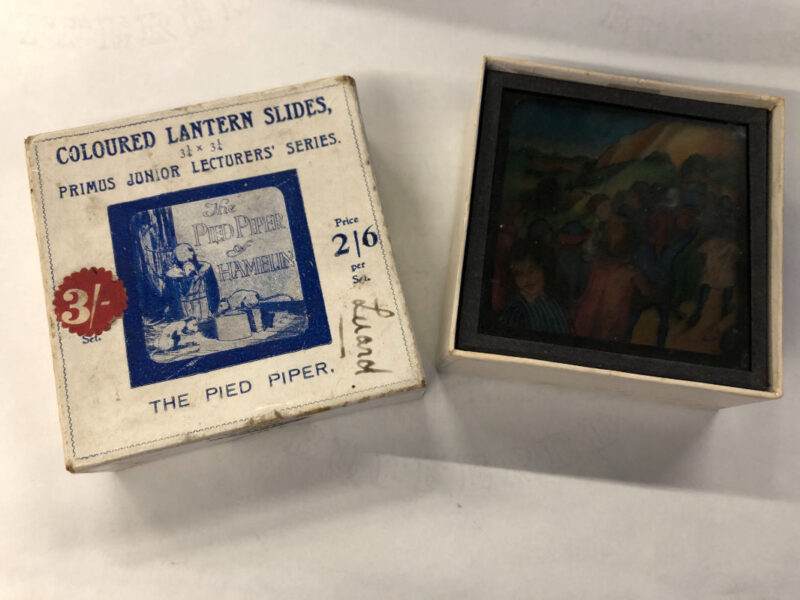
Above: Magic lantern slide before conservation treatment for SOMI changeover. Image: Megan Taylor
Grimwade Centre for Cultural Materials Conservation and Grimwade Conservation Services, The University of Melbourne
Academic programs: teaching and research
In the first six months of this year the Grimwade Centre has three PhD candidates who have finished and submitted their PhDs.
Leila Alhagh’s thesis on: Interdisciplinary approaches to the study of distanciated Islamic manuscripts: ‘Sad Kalamih [Kalima] Shah Vilayat (One Hundred Sayings by Ali): Manzumih [Manzuma] dar Hajj (Futuh al-Haramayn)’ – a case study, focuses on the volume MUL17 ‘Sad Kalamih Shah Vilayat: Manẓūmih dar Ḥajj’ in the Middle Eastern Collection at the University of Melbourne. Utilising qualitative data collection and comparative methodologies within an interdisciplinary approach to the study of distanciated manuscripts, Leila was able to expand methodologies that examine provenance, history, and meaning; provide new insights into assessing authentic bibliographical data and possible dates of production; and enable rich contextualisation of the life and beliefs of the author.
Following the completion of her PhD Leila undertook an internship at the State Library of Victoria, to catalogue and document the Michael Abbott Collection of South-east Asian Islamic Manuscripts. Leila has now graduated as Doctor of Philosophy.
Sophie Lewincamp’s thesis Tiered Contact Zones: A New Engagement Model for Cultural Materials Conservation explores how custodians and others with an interest in a collection, but from vastly different backgrounds and with different areas of collection knowledge or expertise, can best collaborate, share and construct knowledge with conservators who are working with them. Her research is formed by two major case studies: the Middle Eastern Manuscript (MEM) Collection at the University of Melbourne, and the Returned and Services League (RSL) LifeCare War Museum in Narrabeen, New South Wales. In exploring this subject, she has employed a tiered contact zone methodology as a way of understanding what processes are effective. She argues that contact zone theory presents a powerful tool for researchers and communities to design, develop and further their collaborations, for their mutual benefit.
Ainslee Meredith’s thesis on The public value of conservation in Australia: a social justice framework explores the ways in which cultural and heritage collections are linked to a wide range of social benefits. In doing so she explores what conservation expertise and skills might be needed to enable such benefits. She examines spatial inequity and the distribution of conservation resources across Australia, using a mixed-methods study of empirical mapping, critical discourse analysis, and case study interviews. Her findings demonstrate how the discrepancy between the value of these collections and their lack of access to conservation impedes their potential impact. Finally, she concludes that such inequity requires a policy-driven response.
Commercial services
Outreach projects: Conservation in the public eye
The Costume Lab, held in the historic Labassa Mansion, was a public engagement event aimed at showcasing the National Trust Costume Collection through the lens of conservation care and treatment. It was the first time for this kind of event for both GCS and the National Trust.
Conservators Jacinta Brown and Lisa Yeats were engaged to train and supervise a team of 15 emerging conservators undertaking conservation activities pertinent to the needs of the collection. Over ten days, members of the public could circulate through the sumptuously decorated rooms, which made a stunning backdrop for the conservation activities: collection surveying, rehousing, adhesive repairs, washing of whitework clothing, condition reporting, rehousing, and support making for the shoe collection. Several of the key dresses in the collection were rehoused during this time, allowing a rare viewing for the public. The key pieces are all voluminous silk creations, which showed both the beauty of the tailoring and the damaging effects that time and wear can have on silk. The remarkable collection was surveyed during the event for a preservation needs assessment, and it is hoped that the event has generated further interest in the growing 4000-piece collection and will result in further support for its conservation. We are very grateful to the National Trust and the emerging conservators who put in a tremendous effort to make this event such a success.
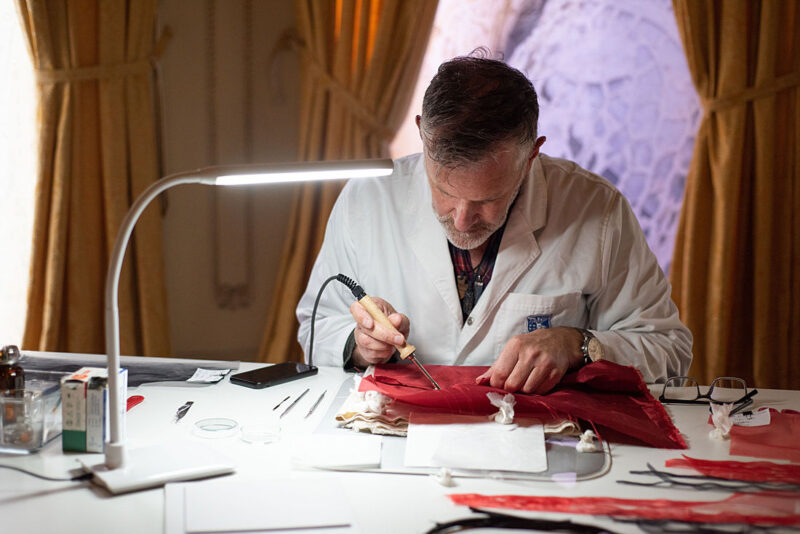
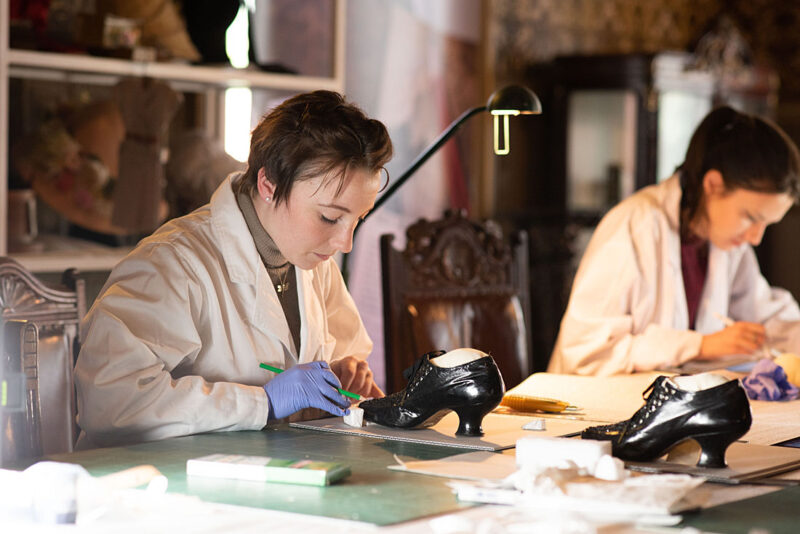
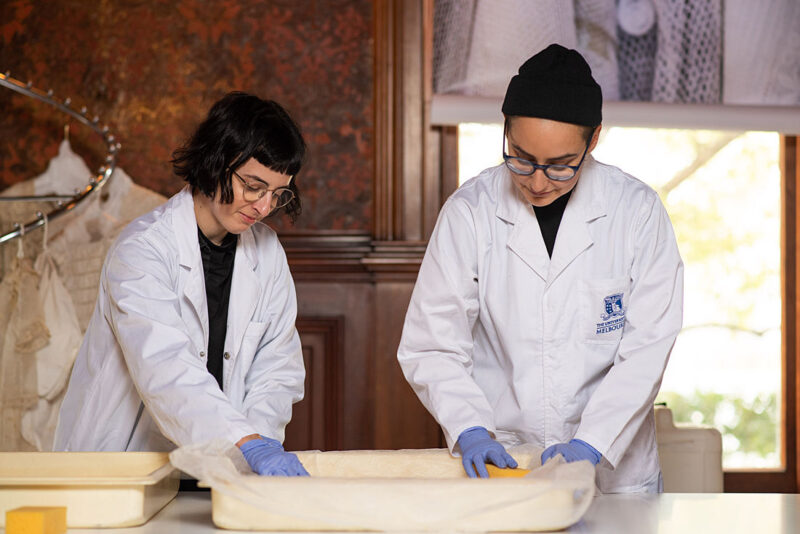
Above: The Costume Lab event. Photographs by Samara Clifford Photography
Port Fairy – Repair Café – Collection Care Day
On Saturday 13 March the Grimwade Centre ran a Collection Care community event in Port Fairy. Residents from the region had the opportunity to receive expert advice on how to care for their precious items and memorabilia. This project was a partnership between GCS, Moyne Shire Council and Port Fairy Community House.
Katy Glen and Cushla Hill were the conservation experts on hand for the day, ably assisted by first-year master’s students Hayley Nolle and Johannah Lamond-Hallett. After a general presentation that covered practical tips on how to care for a wide range of collection materials, one-on-one consultations were offered, allowing people to receive specific advice for their objects. The event was well attended by individuals with family heirlooms, private collectors and representatives from community organisations.
An impressive array of objects was presented, including a well-loved (1st edition) book of fairy tales, historic family photographs, textiles including a 1950s formal dress, incredible 19th century clothing and a handmade wedding dress, a decorative pot from Papua New Guinea and a carved coconut! One of the aims of the project was to create a community engagement activity after a period of social isolation and COVID-19-related anxieties and restrictions. The buzz of enthusiasm amongst the participants, and the presenters, throughout the day indicated that this was achieved. Stories were shared and discussions took place about the responsibilities involved in being the custodians of family heritage. It is hoped that this important task will be helped by the information and resources shared throughout the day, as well as the spark of community connections.
Cook’s Cottage
Lockdown has been hard for many of us. Small museums and historic buildings are no exception. Cook’s Cottage, in Melbourne’s Fitzroy Gardens, is one example of a small museum that suffered a pest problem due to the closing of its doors throughout most of 2020.
Built in 1755, Cook’s Cottage has been a Melbourne icon since 1934. Originally located in Yorkshire, England, and built by the parents of Captain James Cook, the cottage was brought to Melbourne by Sir Russell Grimwade in 1934.
In March 2021, a small team of masked conservators – Bernadette Collins, Imogen Colten, Katherine Topp, Lisa Yeats, Evan Tindal and Sophie Lewincamp – braved the piles of stagnant dust with side scattering of mouse poo … pause for dramatic effect … but, seriously, had to address the problem at hand. It was a rewarding and cathartic experience (especially after prolonged lockdown), returning wooden furniture and metal artefacts to their original lustre. The team also refreshed interpretive displays in preparation for reopening. Cook’s Cottage, Fitzroy Gardens, is a treasure trove of artefacts, well worth a visit, and the kitchen garden is amazing.
New staff
In general news, we welcome new staff to our commercial services team. They are:
- Lisa Yeats—Assistant Conservator, Objects and Textiles
- Camielle Fitzmaurice—Conservator, Paper and Photographs
- Jessica Walsh—Graduate Conservator, Paintings
- Sophie Lewincamp—Projects Conservator
- Jesse Dyer—Grimwade and ACMI Time-based Media Fellow
ICS Melbourne
The ICS Melbourne team recently undertook maintenance work on the marble sculpture collection at Ballarat Botanic Gardens. The team enjoyed the idyllic surrounds and was encouraged by the genuine interest in their work from the visiting public.
Objects conservators Kristine Allinson and Bruno Bell have been working on two archaeological assemblages excavated on King Street. Large quantities of artefacts were uncovered from the sites, which were formerly the location of a girls’ schoolhouse and a grocer’s store.
Bruno Bell has also been working on a number of projects for the State Library of Victoria, including the suit of armour worn by Ned Kelly, the surveyors’ chain reputedly used by Robert Hoddle in laying out Melbourne, the brass bed from Vali Myers studio, and the brass plate bearing the initials of Robert O’Hara Burke and William John Wills, which was once attached to the box bearing their remains.
ICS Melbourne has worked closely with ICS Sydney to treat a collection of water-damaged artworks and frames from Beleura House and Gardens. The team effort will see Sydney Paintings Conservator Eden Christian seconded to Melbourne where she will work beside wood, stone and decorative surfaces conservator Katie Smith.
Katie is also working with textile conservator Marion Parker on a Victorian quilt constructed using military uniforms.
National Gallery of Victoria
Conference, industry and engagement news
Senior Conservator of Frames and Furniture Holly McGowan-Jackson, Paintings Conservator Raymonda Rajkowski and Coordinating Conservator MaryJo Lelyveld presented at the (virtual) 19th ICOM-CC Triennial Conference hosted by Beijing. Raymonda and Holly presented their paper ‘Reflections and transflections on gilding: A preliminary investigation of coatings on gilded picture frames’ as well as a live Q&A panel session, where conference participants ask questions of authors through a moderator. MaryJo co-presented her paper with Dr Joel Taylor from the Norwegian Institute for Cultural Heritage Research on ‘What do we talk about when we talk about “future generations”?’
The Conservation team held its first webinar for the Public Galleries Association of Victoria (PGAV). Focusing on conservation of paper-based works, this is part of a series of monthly ‘Material Speciality’ and ‘Advancements in Collection Care’ webinars being offered to PGAV’s 50-plus members plus affiliates throughout 2021 by the NGV Conservation department.
Interns from the University of Melbourne Cultural Materials master’s course were hosted across the Paper and Photography, Paintings and Exhibitions Conservation studios. These placements are an invaluable opportunity for skills transmission between senior professionals and emerging conservators. A few of these internships have been cut short or put on hold for now but we look forward to welcoming back their intelligent rigor and engaging company in the coming months.
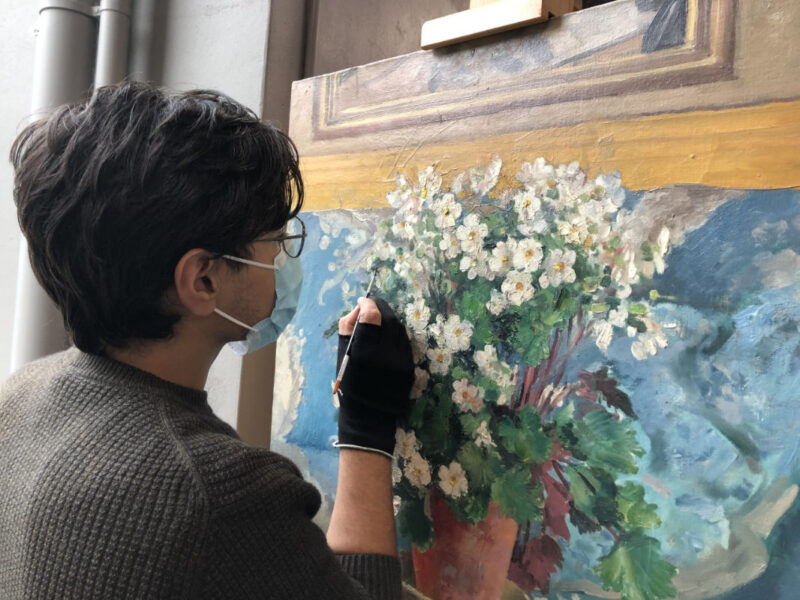
Above: University of Melbourne intern Peter Dellas working on Augustus John’s White Prímula in NGV Painting Conservation. Courtesy of National Gallery of Victoria Conservation department.
The Getty Conservation Institute has loaned the department highly sophisticated acoustic emissions monitoring equipment, which will be used in a research partnership to better understand the physical stressors and dimensional change that occurs on historical panels when transitioning to wider temperature and RH collection environment settings. Practical sessions run via Zoom have enabled Associate Director, Conservation, Michael Varcoe-Cocks and Paintings Conservator Caitlin Breare to test the equipment and allow scientists from the Getty to remotely monitor its performance.
Through the ongoing coordination by Conservation Project Officer Jessica Lehmann, the Conservation team continues to contribute to NGV online learning, audience engagement and social media outreach through a range of projects including: Online Course: Colour; Creativity Matters; and articles and submission for NGV magazine and social media. We contributed a ‘Museum Mystery’ post for Mother’s Day and also shared some recent highlights in stories including the conservation and making of a frame for Thomas Clark’s Upper Falls on The Wannon, and blind embossing and reflectance-transformation imaging, all of which can be viewed on the @ngvmelbourne story highlights. The colour course has been the most popular NGV online course ever run, and the first our team has been involved in—it is great to see the community responding and engaging with conservation stories.
General news
Hello from Victorian lockdown 4.0 (or is it 5.0? 17.0?), although nonetheless a disappointing situation to be in. At least we know how to respond to the situation and take it one isolated day at a time … Pre the ‘stay at home’ orders we were in full swing of an action-packed few months. Exhibition conservators have condition reported for the next exhibition in the Melbourne Winter Masterpieces series, which was due to open in the first week of June, as well of a mix of in-person and virtual condition reporting for the She-Oak and Sunlight: Australian Impressionism and TopArts exhibitions (both open to the public) and the upcoming Camille Henrot exhibition.

Above: Exhibitions Conservator Janelle Borig preparing the TopArts mannequins for display. Courtesy of National Gallery of Victoria Conservation department.
The Conservation team has been involved with the maintenance, deinstall, and packing of works for the Triennial, including the low-temperature pest treatment of Buttpus by Porky Hefer coordinated by Frames and Furniture Conservator Suzi Shaw, and preparation of works for We Change the World, Maree Clarke and History in the Making.
In the Paintings studio the examination and display preparation on the newly acquired painting by Berthe Morisot has been undertaken. This is the first work by Berthe Morisot to enter an Australian collection, and the first work by a female French Impressionist artist in an Australian collection. Major painting treatments have commenced on El Greco’s Portrait of a Cardinal and a newly acquired portrait by Marie-Victoire Lemoine.
Over three days in April, painting conservators were involved in the delivery of separate shipments of Boston MFA Impressionist crates from Sydney to Melbourne. Reporting back was that it was a bonafide luxury to traverse in a different city, though only briefly in Sydney, and it wasn’t unlike a whirlwind trip to Paris resplendent with a croissant on the River Seine …
The Paper and Photograph studio has contributed to the outgoing loans program, including treatment and preparation for 27 paper-based works of art for Tasmania Museum and Art Gallery’s exhibition Paradise Lost: Thomas Griffiths Wainewright. Treatment involved stain reduction, repair and retouching.
Paper Conservator Louise Wilson shared her insight into a specific book from Russia, the Rodchenko and Stepanova USSR in Construction. It has signs of wear showing the history of use, and a central foldout which is a wonderful example of paper engineering, cutting-edge for the time yet in keeping with the content of the book. It has all the signs of a book that has been engaged with and enjoyed, a beautiful idea to think about the living history of works. Click here to watch the video
Amazing works are being examined in the Paper and Photography studio. Photograph Conservator Pip Morrison has been investigating some Ruth Hollick hand-coloured photographs, which arrived from Scotland. This new acquisition is a small album the artist compiled herself of Australian wildflowers and is very beautiful with amazing colours!
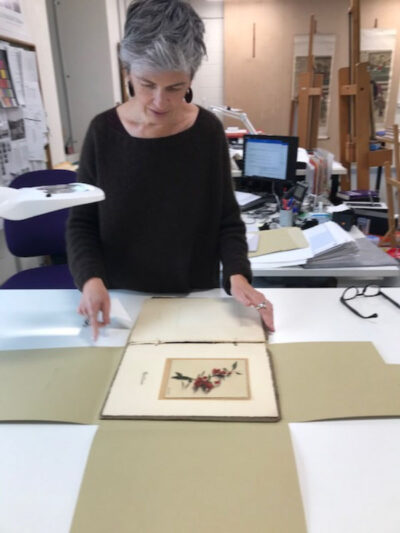
Above: Photograph conservator Pip Morrison condition reporting the newly acquired Ruth Hollick works. Courtesy of National Gallery of Victoria Conservation department.
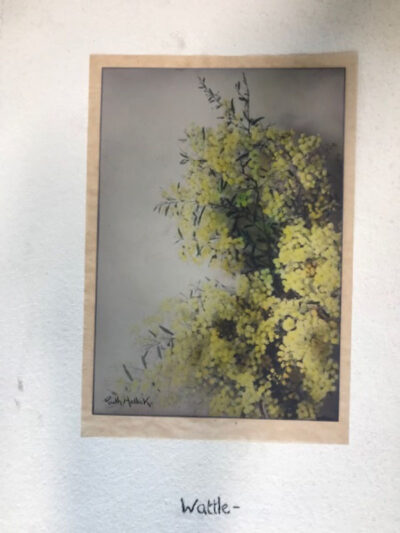
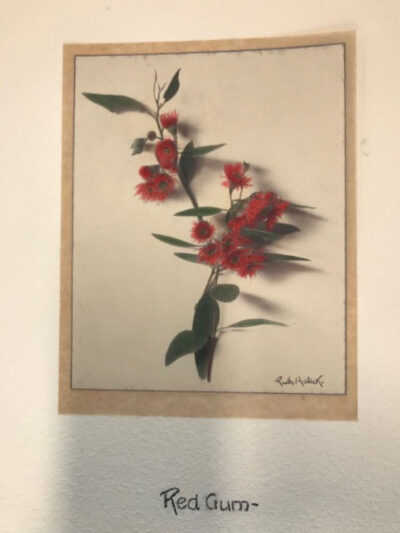
Above: Photograph conservator Pip Morrison condition reporting the newly acquired Ruth Hollick works. Courtesy of National Gallery of Victoria Conservation department.
Senior Paper Conservator Ruth Shervington and Louise have been getting up close and personal with Goya’s works in prep for the upcoming exhibition, including researching the subtleties of Goya’s printmaking techniques and his choice of papers.
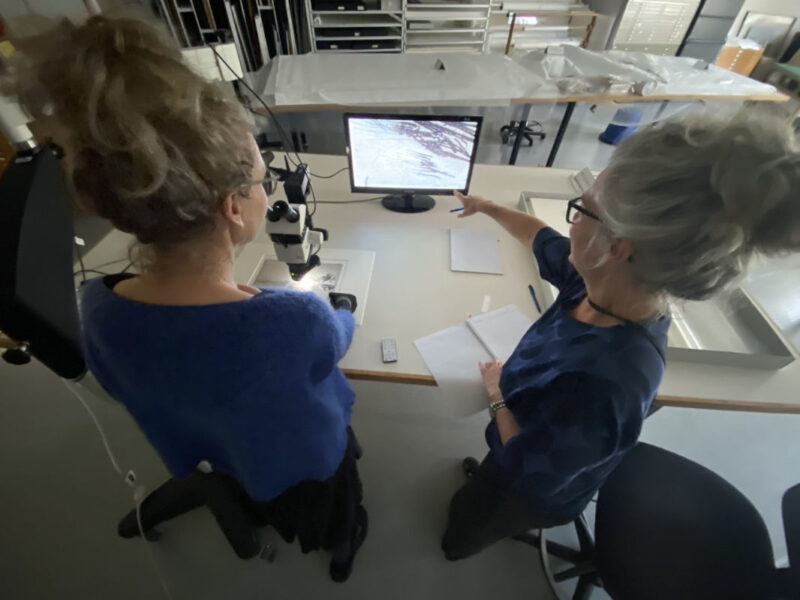
Above: Paper conservators Ruth and Louise looking closely at a Goya print. Courtesy of National Gallery of Victoria Conservation department.
Textiles has been continuing work on the Murdoch Crewelworks, welcoming Elizabeth Murdoch’s granddaughter into the studio to look at the progress of the work. Textiles Conservator Di Knight has definitely taken the research down the rabbit hole, discovering that despite the works coming from Cruden Farm, it’s possible they were originally sourced for Heathfield, a grand mansion in Toorak that the Murdoch’s acquired from the Baillieu family. Textiles Display Technician Ellen Doyle has finished the last of the photography needed for the upcoming blockbuster Chanel show. Treatment also continues on an 18th-century bedcover with ‘bizarre’ embroidery motifs.
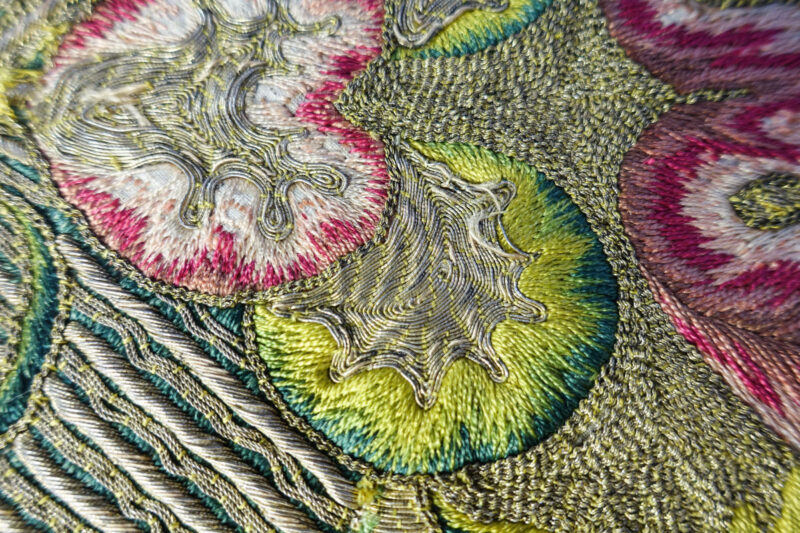
Above: Detail of England bedcover (c. 1710) after textiles conservation treatment. Courtesy of National Gallery of Victoria Conservation department.
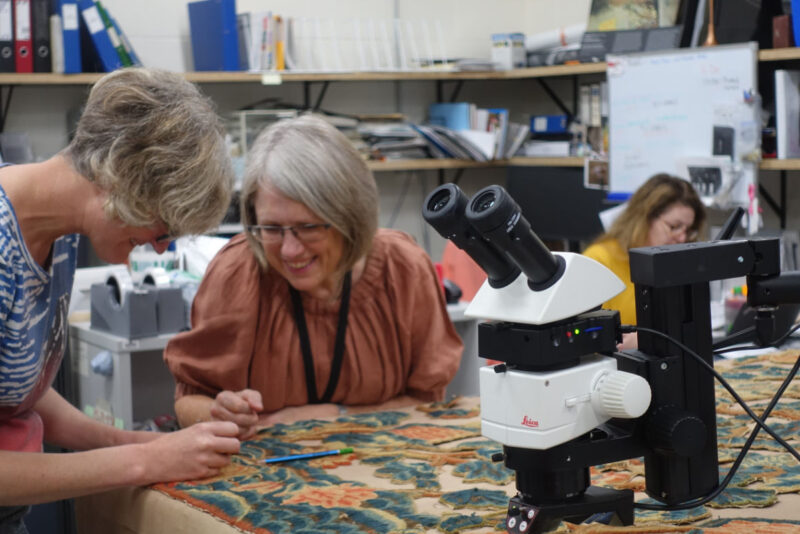
Above: Textiles conservators Di and Kate working on the Murdoch curtains treatment. Courtesy of National Gallery of Victoria Conservation department.
Objects conservation and the mount-makers have been preparing countless object loans and manufacturing mounts for exhibitions at the Australian Centre for Contemporary Art, Geelong Art Gallery and City Gallery (Melbourne).
Some newly acquired works including a group of Sevres figures and a Frank Lloyd Wright window have required treatment by Objects Conservator Trude Ellingsen and Senior Conservator of Objects Marika Strohschnieder, respectively.
Trude wrote a NGV Channel essay on her conservation treatment of Les Kossatz’s Hard Slide.
State Library Victoria
Social news
Collection Care staff have recently featured in a series of short behind-the-scenes videos called the ‘Library Files’, accessible through the State Library’s website and social media channels. Most recently, Jessye Wdowin-McGregor and Emily Keppel demonstrated the rehousing and supporting of textiles from the Irene Watkins collection (YMS 16287). The next one in production features Katrina Ben talking about the World of the Book exhibition and Ian Cox making a giant book cradle at speed.
Staff changes
We are excited to share that Jessye Wdowin-McGregor has accepted an ongoing role as Preservation Technician in the Preservation Team. We are also pleased to announce that Christine Mizzi, who was employed as a Preservation Technician on a short contract, has been extended until the end of October.
Events
Since reopening, we have had a steady stream of tours passing through our spaces and it’s always rewarding to see a high level of interest in our work. In Preservation, tour groups have been particularly interested in the rehousing solutions for such items as World War I medals and ephemera, scrapbooks, diaries, and original photo albums, with many of the participants greatly surprised about the diversity of the Library’s collections.
In April, the Conservation Department hosted second-year paper conservation students from the Master of Cultural Materials Conservation course at the University of Melbourne. This included a morning with Marika Kocsis learning about Japanese paper and the care and maintenance of Japanese tools. The students also spent a day with the book conservators learning about book structures, followed by a workshop on custom phase boxing.
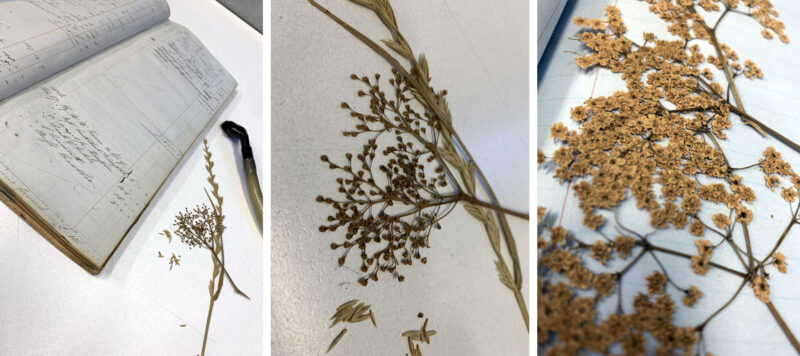
Above: Botanical specimens from ledgers in the Records of Mona Vale Station (YMS 16337). Source: Manuscript Collection, State Library Victoria.
Professional
- Preventive conservation – environmental monitoring
Over the last year, Leah Williams has been busy expanding our environmental monitoring program and installing over 80 data loggers throughout our collection areas, both on and offsite. Our new environmental monitoring is a combination of stand-alone Hobo data loggers and a cloud-based Saveris 2 system in the areas we have wireless. The new equipment provides us with accurate, detailed and continuous environmental data across all our collection areas. The most recent data loggers are in the new display case for Ned Kelly’s armour, and there will be a new external logger installed outside to help us determine the influence of external conditions on our internal environment.
We are very interested to hear from any others who have also installed an external data logger to gather data, and anyone who is using Conserv for environmental monitoring or IPM.
- Preservation projects
George Matoulas continues to manage our custom boxing program, producing boxes for a myriad collection items. Some beautiful 18th century volumes have been thoughtfully boxed to maintain the integrity of the collection as a whole and ensure maximum storage efficiency.
Other Preservation projects involve a diverse array of materials and formats. Recently, Kate Holloway found beautiful botanical specimens interleaved amongst the pages of ledgers from the Records of Mona Vale Station (YMS 16337) while vacuuming the collection in quarantine. Savina Hopkins continues work on the large Vali Myers Archive (LTRE 775), determining packaging solutions for tables, chairs, shoes, and other objects, while Jessye Wdowin-McGregor continues rehousing a range of textiles from the Reis Family Papers (YMS 16251), including priest vestments and related accessories.
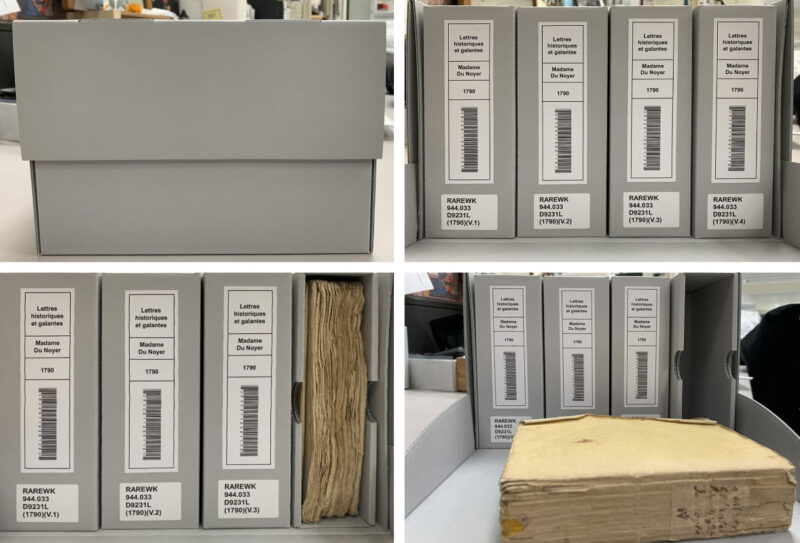
Above: Lettres Historiques et Galantes by Madame du Noyer, 1790 (RAREWK 994.033 D9231L). Source: Rare Books Collection, State Library Victoria.
- Conservation projects
Marika Kocsis recently completed a condition survey of 165 architectural drawings of Melbourne’s St Paul’s Cathedral (H2020.37) by the English Gothic Revival architect William Butterfield (1814–1900), ca. 1880s. The drawings are notable not only because they are created to scale (resulting in some extremely large drawings!), but also because the architect did not leave England, instead conveying the plans to Melbourne by ship. The paper conservation team has now begun the process of stabilising the drawings for digitisation and looks forward to uncovering the incredible architectural details. The pilot program to survey and commence treatment has been generously funded by the Vera Moore Foundation.
Meanwhile, the book conservation team has been busy investigating methods to enhance its leather paring processes. On advice of Gervais Battour from the NGV, we recently invested in a Tormek water-cooled knife sharpener to hone the paring knives. We welcome any questions or comments if others are interested in this equipment!
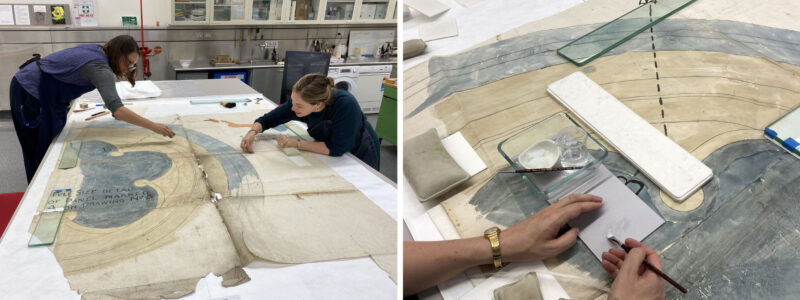
Above: Cleaning and stabilising a to-scale window jamb plan for St Paul’s Cathedral by William Butterfield (H2020.37/132). Source: Pictures Collection, State Library Victoria.
- Research projects
Albertine Hamilton is currently investigating a collection of iron-gall ink drawings by Indigenous artist Tommy McRae (c. 1835–1901) with the aim of facilitating future conservation and preservation activities. The drawings comprise a range of formats—from single sheets to sketchbooks, bound and dis-bound, in varying states of deterioration. Albertine is keen to hear from anyone with previous experience working with similar materials.
- Exhibitions and loans
As the Library is tentatively returning to full capacity following 2020 COVID-19 restrictions, we were excited to see the Changing face of Victoria exhibition finally open. Installation of this exhibition was completed just prior to the Library shutting in March 2020. With some minor conservation adjustments, the exhibition has stayed in sleep mode until now.
In April the Ned Kelly armour returned to permanent display in the South Rotunda, which though beautiful does not meet environmental standards. To provide a long-term stable display environment we engaged European Museum Technology (EMT) and installed a display case with an active humidity control unit (MiniClima), and monitored with the new Testo Saveris data loggers. While off display, the armour was fully documented and condition reported.
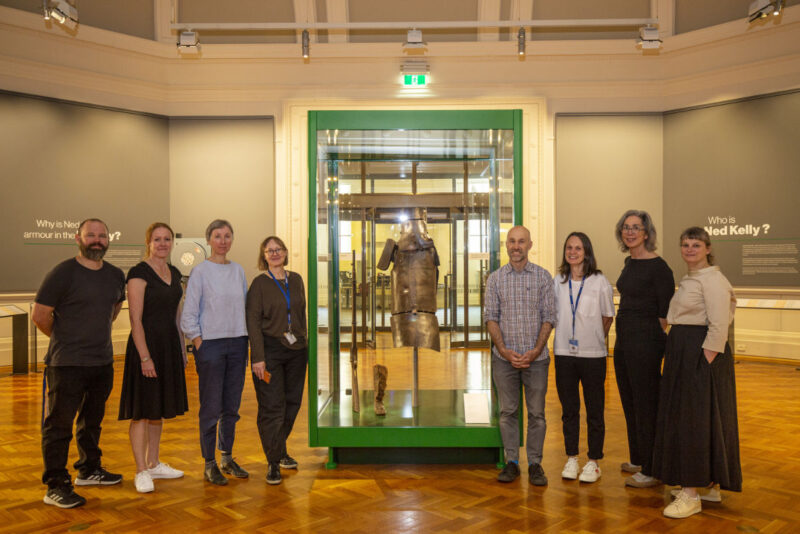
Above: Exhibition, Registration and Conservation staff complete the relocation of Ned Kelly’s armour (H20171) and rifle (H2002.136) in the South Rotunda. Source: Pictures Collection, State Library Victoria.
Conservation continues to contemplate the display and storage of an unusual oversized knitted celestial map called Stargazing, recently donated to the Library. This work by Sarah Spencer is scheduled to go on display in Victoria Gallery in early 2022. Measuring 2900 x 4400mm, the three-colour machine-knitted double jacquard tapestry captures 88 constellations across the hemispheres, including the Milky Way, and will be lit by over 1000 tiny LED lights attached to a programmable circuit board. It poses some interesting preservation and display questions!
The Registration team recently dispatched two paintings for display in Archie 100: A Centenary of the Archibald Prize at the AGNSW, after which they will tour for three years to eight venues, nationwide. To prepare for the loan, Portrait of Archbishop Mannix by Max Martin was treated by external painting conservator Helen Gill and then fitted with a custom display mount that will enable the double-sided painting to sit on a plinth and be viewed from both sides. Mr Georges Mora by Caroline Williams was refitted with a cam-lining by Jarno Coone and Jane Hinwood to provide extra support to the canvas throughout its extensive tour.
Conference attendance
There has been little to celebrate with COVID, but the explosion of online conferences, webinars and training opportunities has been one of the few small boons, especially for us here in Australia. Our book conservators recently attended the University of Copenhagen’s 18th Seminar on the Care and Conservation of Manuscripts, conducted online for the first time. For further information, please see Bonnie Hearn’s review.
The Art Doctor
New private conservation business open in Victoria, sharing suppliers and stockists of some hard-to-find essentials.
Cash Brown BFA, MCMC
The lockdowns we endured in Victoria during 2020 allowed time for reassessment and reflection for many of us. The lack of employment opportunities, and inability to continue to travel for work, prompted me to take the plunge and launch The Art Doctor, a small conservation business based in Sorrento on Victoria’s Mornington Peninsula, specialising in easel paintings, painted objects and digital preservation of photographs and documents. I am fortunate that a friend and former colleague was opening a contemporary art gallery close to my home and offered a place for me to set up a lab nestled inside the gallery. This is wonderful for exposure and advocacy and forms a symbiotic business relationship and an environment where I am not alone all day, which is an important consideration for health and safety.
A thorough business plan and budget, assisted by Job Keeper payments, supported establishment costs, and I am thrilled with the investment in quality equipment which will serve me well for the rest of my career. There was a lot of frustration in trying to source much of the equipment and many of the materials, while others were straightforward. Sourcing components for the Modular Cleaning Program has taken a lot of time but was well worth the effort to set up such a comprehensive set of materials. The ‘Modular Cleaning Program in Practice’ Facebook group is a fabulous place to get help when you need it and to help others.
I would like to share my sources in the hope that it saves colleagues in the profession time and money. I am grateful also to professional colleagues for allowing me to purchase small quantities of their stocks that are either currently unavailable from national and international suppliers or impossible to import, including Laropal A81, Beva gel and Pemulen TR2. Archival Survival is wonderful for bringing in materials from Talas – I only wish I had known this earlier and could have saved a small fortune on freight. I have also included a few useful publications, which can be downloaded, and even my public liability and professional indemnity insurance provider in the table below. There are many more items of course that were purchased to set up the lab, which are mostly eBay and hardware-store lines and too numerous to reasonably list. I still cannot access any cyclododecane in small quantities; can anyone help?
Equipment and consumables sources 2020-2021
| Item/s | Supplier | URL |
| MS3, Paraloid B-67, ethylcellulose, ShellSol D, plasticiser, preservative (equivalent of Germaban for aqueous solutions spoilage prevention), Gamsol and ground pigments including lapis lazuli | St Luke Artist Colourmen (Melbourne) | https://stlukeart.com/ |
| Tengucho Kozo Tissue 64 x 97 cm 9 gsm | Caulfield Art Supplies | https://www.ebay.com.au/usr/caulfieldartsupplies |
| Dacron sailcloth | Wooden Boat Shop, Portsea, Victoria | https://woodenboatshop.com.au/ |
| xylene, butan-1-ol, 32% HCl, ammonium hydroxide 20% solution, sodium hydroxide 0.1M, trimethylpentane, acetone, diacetone alcohol, triacetic acid (HEDTA), abietic acid, propan-1-ol, Brij 35 solution, benzyl alcohol, trimethylpentane, pipettes and reagent bottles | Rowe Scientific | https://www.rowe.com.au/rowe/Home.htm |
| ShellSol T, ethanol, methanol, n-methyl pyrrolodine (NMP), propan-2-ol, ShellSol D 60 | Sydney Solvents | https://www.sydneysolvents.com.au/ |
| triethanolamine (TEA) | eBay | https://www.ebay.com.au/itm/233980557366?hash=item367a53f836:g:Eq4AAOSw~oFXH1wY&frcectupt=true |
| tris, deoxycholic acid, DTPA, Surfonic JL-80X, Ethofat 242-25, bicene, Lascaux welding powder and Temart fixing plates | Museum Services Corporation (USA) | https://museumservicescorporation.com/ |
| EDTA (disodium) | eBay | https://www.ebay.com.au/itm/293192726176?var=592376481208 |
| Carbopol 940 | eBay | https://www.ebay.com.au/itm/293733179691?var=592533035792 |
| bis-tris | https://www.ebay.com.au/itm/162627531384?var=461626888957 | |
| Selvol E 107 PVOH, Cosmoloid 80H, Beva 371, Gamblin Conservation Colors, glass microballoons, Beva Gesso-P (Fine Texture), Methocel A4, methylcellulose, Aquazol 200 and 500, Tinuvin 292, Regalrez 1094, sturgeon glue, Ethomeen C25 (C12 cannot be imported as it is classified as dangerous goods) | Talas via Archival Survival. You will need to go onto the Talas website and get the name of product and SKU – then contact Archival Survival with your order. Note some goods are classified as dangerous and cannot be freighted. | https://www.talasonline.com/ |
| The Handbook of Solvents
|
https://books.google.com.au/books?id=NzhUTvUkpDQC | |
| Nanoscience for the conservation of works of art, RSC nanoscience & nanotechnology 28
|
https://www.researchgate.net/publication/285309171_Nanoscience_for_the_conservation_of_works_of_art_RSC_nanoscience_nanotechnology_28 | |
| Gels for the Conservation of Cultural Heritage
|
https://pubs.acs.org/doi/pdf/10.1021/la900961k | |
| Gels for the Cleaning of Works of Art | https://pubs.acs.org/doi/full/10.1021/bk-2018-1296.ch015 | |
| low mass hot suction table, non-contact IR heat tool and controller unit, suction platen | RH Conservation Engineering
(Victoria) |
http://www.rhconservationeng.com |
| 90X boom arm trinocular simul-focal stereo microscope + HDMI camera Barlow lens, LED light ring | eBay | https://www.ebay.com.au/itm/311757390566?hash=item48963042e6:g:vhcAAOSw44BYS9NP |
| professional indemnity and public liability insurance | Flying Arts Inc. | https://flyingarts.org.au/ |